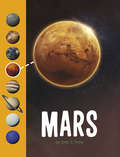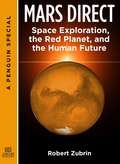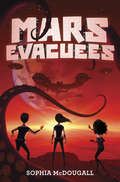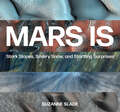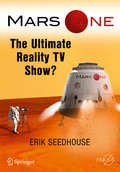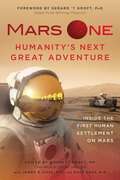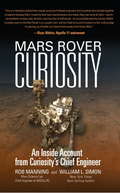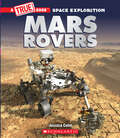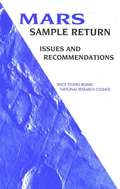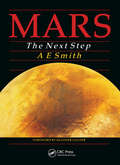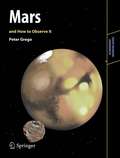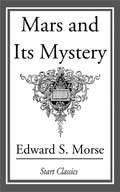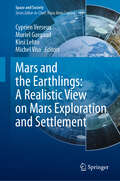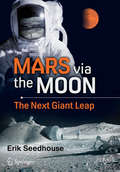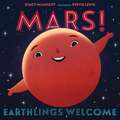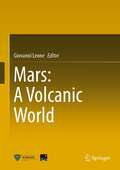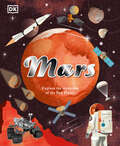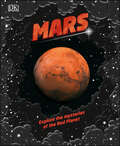- Table View
- List View
Mars (Planets in Our Solar System)
by Jody S. RakeMars is famous for its coloring, but the fourth planet from the sun has more than that going for it. Discover more interesting facts and secrets about the famous "red planet."
Mars (The Galaxy)
by Steven L. KippHow long is a day on Mars? How many moons does it has? How big is its largest volcano? How can you make martian sand on earth?
Mars (World Book's Solar System and Space Exploration Library)
by Al SmuskiewiczIntroduction to Mars, providing to primary and intermediate grade students information on its features and exploration. Includes fun facts, glossary, resource list and index.
Mars Architecture: Construction 6.0 for Designing Sustainable and Health-Oriented Habitats
by Amjad Almusaed Ibrahim Yitmen Asaad AlmssadThis book combines Construction 6.0 with AEC principles for designing sustainable, health-focused Martian habitats. It unveils innovative architectural designs ideal for Mars, utilizing 3D printing, autonomous robotics, and regolith, alongside renewable energy and life support systems. With an emphasis on well-being, it integrates biophilic design and digital technologies to enhance operational efficiency. Exploring various habitat models, it advocates a multidisciplinary approach to extraterrestrial colonization that balances technological advancement with environmental and ethical stewardship, aiming to make human life on Mars a healthy and sustainable reality.
Mars Direct
by Robert ZubrinThe human race is at a crossroads. In the coming years, we will make decisions regarding our human spaceflight program that will lead to one of two familiar futures: the open universe of Star Trek, where we allow ourselves the opportunity to spread our wings and attempt to flourish as an interplanetary species-or the closed, dystopian, and ultimately self-destructive world of Soylent Green. If we ever hope to live in the future that is the former scenario, our first stepping stone must be a manned mission to Mars. Dr. Robert Zubrin details the challenges of a manned Earth-to-Mars mission. Challenges which, according to Zubrin, we are technologically more prepared to overcome than the obstacles of the missions to the moon of the sixties and seventies. Dr. Zubrin's relatively simple plan, called Mars Direct, could feasibly have humans on the surface of Mars within a decade. Zubrin also discusses the current predicament of NASA, the promise of privatized space flight from companies like SpaceX, and the larger implication behind the absolute necessity to open the final frontier to humanity-the human race's future as a species that takes the necessary baby steps away from the cradle that is planet Earth or, ultimately, perishes here.
Mars Evacuees
by Sophia McdougallFrom bestselling UK author Sophia McDougall comes one fresh and funny, adventure-filled tween debut about a group of kids evacuated to Mars! Perfect for fans of Artemis Fowl, this laugh-out-loud series is packed with nonstop fun. When Earth comes under attack by aliens, hilarious heroine Alice Dare and a select group of kids are sent to Mars. But things get very strange when the adults disappear into thin air, the kids face down an alien named Thsaaa, and Alice and her friends must save the galaxy!For when plucky twelve-year-old Alice Dare learns she's being taken out of the Muckling Abbott School for Girls and sent to another planet, no one knows what to expect. This is one wild ride that will have kids chuckling the whole way through.
Mars Is: Stark Slopes, Silvery Snow, and Startling Surprises
by Suzanne SladeAward-winning author and former rocket engineer Suzanne Slade explores the diverse magnificence of Mars in this photo-packed extravaganza, perfect or readers eagerly following NASA's Mars Exploration Program!For centuries, people have been intrigued by Mars, and over time, scientists have made exciting discoveries, such as the planet's Earth-like weather and seasons. But curious earthlings want to know more about the Red Planet. Does Mars have deserts? Volcanos? Or signs of life? Could people live there someday?Scientists decided to take a closer look. They built a powerful camera called the HiRISE (High Resolution Imaging Science Experiment) and loaded it onto a rocket. The rocket blasted off on August 12, 2005, and seven months later, the camera began orbiting Mars. It sent back surprising, revealing photos showing the world what Mars really is. Now, the world's space community and NASA have renewed their exploration efforts, and interest in the Red Planet is in high gear.With elegant, spare prose, Suzanne Slade leads readers through some of the stunning photos taken by the most advanced camera ever sent to another planet. A visual feast for space enthusiasts and STEAM fans. Features remarkable full-color photography throughout.
Mars Landing 2012
by Marc KaufmanNational Geographic presents the science, the goals, and the anticipation of humankind's most ambitious planetary expedition ever: the Curiosity mission to Mars. On August 6, 2012 (EST), NASA's Curiosity spacecraft will complete its 255-day, 354-million-mile journey and plunge down into Gale Crater, its target on the martian surface, decelerating from 13,200 to 0 mph in 7 minutes. The whole world will be watching this, the most complicated and precise landing ever undertaken, and wondering: What's the inside story on this Curiosity mission, and what do NASA scientists hope Curiosity will find? In this e-short, written by Washington Post science correspondent Marc Kaufman and published just as the suspense builds, with Curiosity hurtling toward Mars, space science readers, techies, and informed news junkies will find answers to these and other fascinating questions about the red planet.
Mars Landing 2012: Inside the NASA Curiosity Mission
by Marc KaufmanOn August 6, 2012 (EST), NASA's Curiosity spacecraft will complete its 255-day, 354-million-mile journey and plunge down into Gale Crater, its target on the martian surface, decelerating from 13,200 to 0 mph in 7 minutes. The whole world will be watching this, the most complicated and precise landing ever undertaken, and wondering: What's the inside story on this Curiosity mission, and what do NASA scientists hope Curiosity will find? In this e-short, written by Washington Post science correspondent Marc Kaufman and published just as the suspense builds, with Curiosity hurtling toward Mars, space science readers, techies, and informed news junkies will find answers to these and other fascinating questions about the red planet.
Mars One
by Erik SeedhouseThis book dissects the hype and hubris of the Mars One venture. Every aspect of the mission design is scrutinized, from the haphazard selection process to the unproven mission architecture. A controversial project, many professional astronauts consider Mars One a reckless attempt, yet it gained popular attention. This go-to reference guide provides the reader with insights into the myriad issues arising from the project's loss of funding, loss of sponsorship, loss of TV rights. It explains what contributed to an overly optimistic assessment of Mars One's mission-specific technology, and what captivated the public and the many willing candidates despite these flaws. From the author of Survival and Sacrifice in Mars Exploration (2015) among many more books on spacefaring, this is yet another up-to-the-minute account of an emerging player in the private space market from an expert on the subject.
Mars One: Inside the First Human Settlement on Mars
by NORBERT KRAFT, JAMES R. KASS AND RAYE KASSHuman curiosity has led us to explore our solar system, landing on the moon and sending spacecraft to study distant planetary objects. The next step in our great adventure is putting humans on Mars, but what will it really take to achieve this? In 2011, Mars One announced its intentions to establish a permanent human settlement on Mars beginning as early as 2024; in 2013 it launched its astronaut-selection program and received thousands of applications. The highly anticipated Mars One documentary series will provide a window into the captivating details of the crew selection and training process, allowing the whole world to follow along as Mars' first settlers prepare for their mission. Now, with Mars One: Humanity's Next Great Adventure, you can step even further inside the experience of these astronaut pioneers and explore the various human dimensions of Mars One's planned expeditions. Edited by Norbert Kraft, MD, Mars One's Chief Medical Officer and head of crew selection and training, as well as crew selection and training committee members James R. Kass, PhD, and Raye Kass, PhD, this collection of essays from scientists, psychologists, and more provides a behind-the-scenes look at the process and criteria used to choose candidates, fascinating details about what they'll learn, and predictions about their future lives on Mars. Inside, you'll find in-depth discussions of: The essential skills and training the Mars One astronauts will need to journey to and then survive on Mars, from technical and medical know-how to the interpersonal skills necessary for working in confined quarters so far from home The challenges of going through the selection and training process while being watched by millions around the world, and what Mars One hopes watching the process will mean for viewers at home Inside information, including images, on the planned Mars One habitats and colonization timeline What settlers can expect on Mars, from daily work activities in a hostile environment to communication with Earth and options for leisure time The book also includes excerpts from candidate questionnaires, allowing readers to enter the minds of prospective Martians like never before.
Mars Rover Curiosity
by William L. Simon Rob ManningThe firsthand account of the trials and tribulations of engineering one of the most complex pieces of space technology, the Mars Rover Curiosity, by its chief engineer Rob ManningIn the course of our enduring quest for knowledge about ourselves and our universe, we haven't found answers to one of our most fundamental questions: Does life exist anywhere else in the universe? Ten years and billions of dollars in the making, the Mars Rover Curiosity is poised to answer this all-important question.In Mars Rover Curiosity: An Inside Account from Curiosity's Chief Engineer, Rob Manning, the project's chief engineer, tells of bringing the groundbreaking spacecraft to life. Manning and his team at NASA's Jet Propulsion Laboratory, tasked with designing a lander many times larger and more complex than any before, faced technical setbacks, fights over inadequate resources, and the challenges of leading an army of brilliant, passionate, and often frustrated experts.Manning's fascinating personal account--which includes information from his exclusive interviews with leading Curiosity scientists--is packed with tales of revolutionary feats of science, technology, and engineering. Readers experience firsthand the disappointment at encountering persistent technical problems, the agony of near defeat, the sense of victory at finding innovative solutions to these problems, the sheer terror of staking careers and reputations on a lander that couldn't be tested on Earth, and the rush of triumph at its successful touchdown on Mars on August 5, 2012. This is the story of persistence, dedication, and unrelenting curiosity.
Mars Rovers (A True Book (Relaunch))
by Jessica CohnFrom the first time a person looked up at the sky and wondered “What’s out there?” humans have dreamed about exploring the cosmos.This book is part of a series, A True Book: Space Exploration, that includes the titles Human Missions to Outer Space, Mars Rovers, The International Space Station, and UFO's. The series features the latest NASA imagery and lively text to bring the wonder of space exploration directly to readers.For so long, our neighbor in the solar system has been shrouded in mystery. Was there ever life on Mars? How can we enable astronauts to land on that planet—and return safely? Mars rovers, including the latest: Perseverance, may just provide the answers! They might even tell us if humans can live on Mars one day! Share in the joy of exploration and discovery with Mars Rovers.
Mars Sample Return: Issues And Recommendations
by Task Group on Issues in Sample ReturnA report on the Mars Sample Return
Mars The Next Step
by Arthur E. SmithThe conquest of Earth's moon was merely a precursor to a more dramatic step forward, which will take men and women to an outpost that might eventually become a second home for the human race. Mars: The Next Step illustrates how the only feasible colonization of another planet in our solar system will be on Mars. The author addresses the various questions surrounding this theory with frank scientific caution that in no way obscures his vigorous enthusiasm and, above all, optimism for mankind's future in space. This vivid and entertaining book explores "terraforming" (planetary engineering), which could turn Mars into a more congenial environment for humans, both in terms of changing the harsh climate of the planet and the production of plants able to thrive there by means of genetic engineering. The book includes numerous diagrams of possible manned spacecraft, along with color pictures of Mars taken on previous unmanned missions.
Mars and How to Observe It
by Peter GregoMars, popularly known as the Red Planet because of its distinct color, is visible with the naked eye and is one of very few planets in the Solar System in which it is possible to see weather phenomena and surface features and thus is a favorite for amateur and practical astronomers. Commercially made telescopes can reveal its dusty surface markings, brilliant polar ice caps, and atmospheric phenomena. Many of Mars's features appear to change shape and intensity with the seasons: its polar caps grow and shrink cyclically, clouds billow above the Martian surface, and sometimes great dust storms obscure vast sections of the planet. The first part of Mars and How to Observe It sets out our current knowledge of Mars as a planet - its orbit, physical characteristics, evolution over time, and current geology. A planet-wide tour of Mars's topography is featured, along with clearly labeled maps and close-up images of a variety of features. The second part of the book explains how amateur and practical astronomers can observe Mars successfully. Many aspects are considered in depth, including preparing to observe, calculating phase and tilt, and making observational sketches and drawings. There are also plenty of details about how best to make high-resolution CCD images. Since Mars changes in its apparent size in the sky according to its position in relation to Earth, it is best observed during its closest approaches. Future apparitions (appearances of the Red Planet) are therefore featured.
Mars and Its Mystery
by Edward S. MorseInspired by his friend and astronomer Perival Lowell and his visits to the Lowell Observatory in Flagstaff, Arizona, Morse published Mars and Its Mystery in defense of Lowell's controversial speculations regarding the possibility of life on Mars.
Mars and the Earthlings: A Realistic View on Mars Exploration and Settlement (Space and Society)
by Muriel Gargaud Kirsi Lehto Michel Viso Cyprien VerseuxIn an era of public Mars fascination, this book offers an objective presentation of the challenges of crewed Mars missions and discusses scenarios of Mars settlements under scientific, technical, social, economic , ethical and political aspects. With the aim to make the reader comprehend what is plausible and what is at stake, the book tries to clarify misconceptions and half-truths spreading rapidly in the public. The authors argue that approximations and misinformation should be countered for two main reasons. First, to avoid missing out on the benefits that Mars exploration may bring, including major scientific discoveries and an inspiring, federative human endeavor. Second, to remediate dangerous delusions – such as the idea that humanity could be transferred there should the Earth become inhabitable in the near term. In preparation for this book a group of European, world-renowned scientists from fields as diverse as astronomy, planetology, geology, biology, philosophy, or economics, as well as astronauts and science-fiction writers, was gathered to discuss Mars missions ranging from near-term robotic missions, all the way to large-scale settlements and even the feasibility of terraforming. For each, they draw arguments from their domains of expertise to discuss what is feasible and what is desirable. The result provides researchers with an objective review of the field, policy makers with a reference to make informed decisions, and the general public with a tool to form educated opinions.
Mars via the Moon
by Erik SeedhouseMOMENTUM IS BUILDING for a return to the Moon. NASA''s international partners on the International Space Station are in favor of returning to the lunar surface, as are India and China. The horizon goal may be Mars, but the political, funding and the technological and medical infeasibility of such an objective means the next logical step is a return to the Moon. While much has been learned about the Moon over the years, we don''t understand its resource wealth potential and the technologies to exploit those resources have yet to be developed, but there are a number of companies that are developing these capabilities. And, with the discovery of water in the lunar polar regions, plans are in the works to exploit these resources for fuel for transportation operations in cis-lunar space and in low Earth orbit (LEO). The time has come for commercial enterprise to lead the way back to the lunar surface. Embarking on such a venture requires little in the way of new technologies. We don''t need to develop super-fast propulsion systems like those required to get us to Mars safely, nor do we need hundreds of billions of dollars that the experts reckon it will cost to transport humans to the Red Planet. What we do need is a place to test the technologies and deep space experience that will enable us to build a pathway that will lead us to Mars. That place is the Moon and this book explains why. The time has come for commercial enterprise to lead the way back to the lunar surface. Embarking on such a venture requires little in the way of new technologies. We don''t need to develop super-fast propulsion systems like those required to get us to Mars safely, nor do we need hundreds of billions of dollars that the experts reckon it will cost to transport humans to the Red Planet. What we do need is a place to test the technologies and deep space experience that will enable us to build a pathway that will lead us to Mars. That place is the Moon and this book explains why. The time has come for commercial enterprise to lead the way back to the lunar surface. Embarking on such a venture requires little in the way of new technologies. We don''t need to develop super-fast propulsion systems like those required to get us to Mars safely, nor do we need hundreds of billions of dollars that the experts reckon it will cost to transport humans to the Red Planet. What we do need is a place to test the technologies and deep space experience that will enable us to build a pathway that will lead us to Mars. That place is the Moon and this book explains why. OMENTUM IS BUILDING for a return to the Moon. NASA''s international partners on the International Space Station are in favor of returning to the lunar surface, as are India and China. The horizon goal may be Mars, but the political, funding and the technological and medical infeasibility of such an objective means the next logical step is a return to the Moon. While much has been learned about the Moon over the years, we don''t understand its resource wealth potential and the technologies to exploit those resources have yet to be developed, but there are a number of companies that are developing these capabilities. And, with the discovery of water in the lunar polar regions, plans are in the works to exploit these resources for fuel for transportation operations in cis-lunar space and in low Earth orbit (LEO). The time has come for commercial enterprise to lead the way back to the lunar surface. Embarking on such a venture requires little in the way of new technologies. We don''t need to develop super-fast propulsion systems like those required to get us to Mars safely, nor do we need hundreds of billions of dollars that the experts reckon it will cost to transport humans to the Red Planet. What we do need is a place to test the technologies and deep space experience that will enable us to build a pathway that will lead us to Mars. That place is the Moon and this book explains why. The time has come for commercial enterprise to lead the way back to the lunar surface....
Mars! Earthlings Welcome (Our Universe #5)
by Stacy McAnultyFrom writer Stacy McAnulty and illustrator Stevie Lewis, Mars! Earthlings Welcome is a light-hearted nonfiction picture book about the red planet—told from the perspective of Mars himself...Meet Mars! The red planet. Planet Marvelous. Favorite sibling of Earth (or so he claims). Sometimes they're close (just 34.5 million miles apart). Sometimes they need space (250 million miles apart)! Earth and Mars have a lot in common—clouds, mountains, polar icecaps. And while Earth has Earthlings, Mars makes a persuasive case for why people should make the journey to spend time with him. His day is 7 minutes longer! He is home to the largest volcano in the whole solar system. He's, well, marvelous. With characteristic humor and charm, Stacy McAnulty channels the voice of Mars in this next celestial "autobiography" in the Our Universe series. Rich with kid-friendly facts and beautifully brought to life by Stevie Lewis, this is an equally charming and irresistible picture book.
Mars: A True Book
by Larry Dane BrimnerMars has always been a planet of mystery. To observers on Earth, it looks like a red disk. Its color comes from the red dust on its surface. When the red dust gets stirred up by strong winds, the planet's red color is even more intense. This explains why Mars, the fourth planet from the Sun, is sometimes called the Red Planet. The book solves all the mystery surrounding Mars.
Mars: A Volcanic World
by Giovanni LeoneThis book is a comprehensive advancement about the understanding of the volcanology of Mars in all its aspects, from its primary formation to its evolution in time, from the smaller structures to the bigger structures. It discusses the implications of volcanism in the general environmental and geological context of Mars. The book is validating the Southern Giant Impact Hypothesis explaining the formation of Mars in an interdisciplinary approach, including mineralogical, geochemical, volcanological as well as geomorphological information. Implications for future explorations in terms of resources are provided. This book serves as a textbook for undergraduate and graduate level to foster new basic research in the field of planetary volcanology and is a new guide for future missions toward a volcanic world, including new detailed information for the general audience who is always keen to know more about the history of Mars and its large volcanoes. The book also presents an updated situation about the water resources of the planet.
Mars: Explore the Mysteries of the Red Planet (Space Explorers)
by Giles Sparrow DK Shauna EdsonThis ultimate guide to Mars launches 7–9 year olds on a breathtaking journey through the past, present, and future of the Red Planet with stunning illustrations, photographs, and fascinating information.Has there ever been life on Mars? Will we be living there soon? How? Discover the past, present, and future of the mysterious Red Planet in this beautiful nonfiction book for kids. It explores the evidence for past life on Mars, what's happening there now, and what it might look like to one day live on the Red Planet. Be amazed by the tallest mountain in the solar system, discover how houses on Mars could look, and find out if you've got what it takes to join the teams traveling to Mars in the future.Packed with fun illustrations by artist Mark Ruffle, combined with images from space agencies such as NASA and ESA, information panels, and diagrams, children will adore this essential guide to the Red Planet. This reissue has been created to ensure the facts and information are up to date with the latest science and technology.
Mars: Explore the mysteries of the Red Planet
by DKHas there ever been life on Mars? Will we be living there soon? HOW?! Discover the past, present, and future of the mysterious red planet in this beautiful non-fiction book for kids.The launch of Mars rovers by NASA, Europe, and China in 2020 will be the biggest science news of the year and will reveal more about Mars than ever before. Get ahead with this amazing new book, which explores the evidence for past life on Mars, what's happening there now, and what it might look like to one day live on the red planet. Discover incredible space technology, learn how to spot the planet in the night sky throughout the year, and find out if YOU'VE got what it takes to join the teams traveling to Mars in the coming years.Children will adore this essential guide to the red planet. Incredible images and fun illustrations will ignite their imagination and give them a fascinating insight into what the future might hold...
Mars: From Myth and Mystery to Recent Discoveries
by Markus HotakainenThis absorbing book tells the story of Mars since the dawn of mankind's curiosity for celestial wonders. It covers everything, right from our ancient beliefs, through the revolution in our concepts of the cosmos around us in the 1600s, to the present day knowledge and beyond. It takes the reader on a journey all the way to the futuristic visions of science fiction and terraformed Mars with conditions suitable to Earth life. The story is told in a readable form with an absence of technical jargon. The text is supported by informative imagery and a simple, but inspiring layout with some special features such as a "flip movie" of the rotation of Mars.
